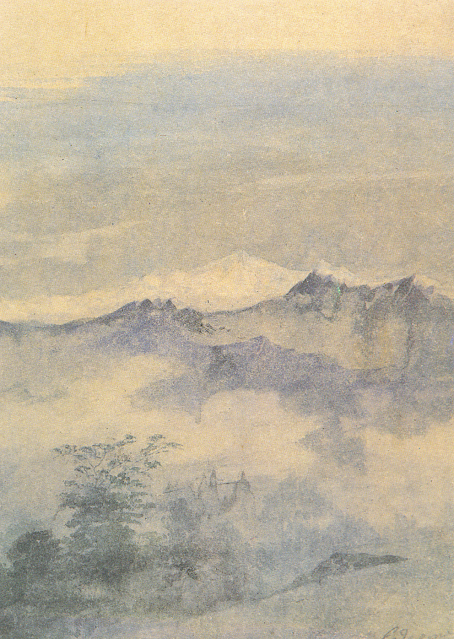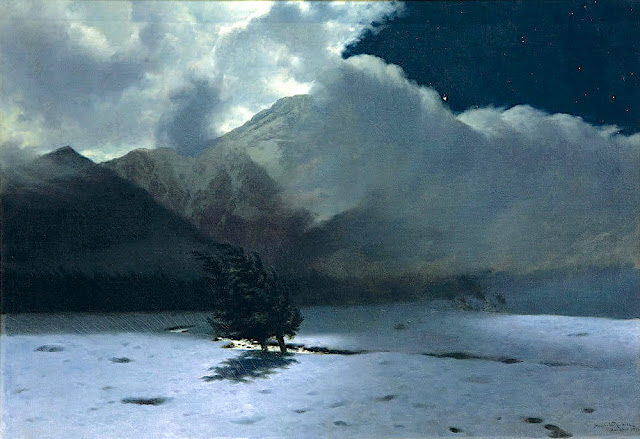
Tofane (3,244 m - 10,643 ft)
Italy
In Tofane as seen from near Cortina d'Ampezzo, Tyrol. 1866 , Birmingham Museum and Art Gallery
The mountain
Tofane
is a mountain group in the Dolomites of northern Italy, west of Cortina
d'Ampezzo in the province of Belluno, Veneto. Most of the Tofane lies
within Parco naturale delle Dolomiti d'Ampezzo, a nature park. The
highest peaks of the Tofane group are Tofana di Mezzo (3,244 m -10,643
ft), Tofana di Dentro (3,238 m-10,623 ft), and Tofana di Rozes (3,225 m
-10,581 ft). Tofana di Mezzo is the third highest peak in the Dolomites,
after Marmolada (3,343 m -10,968 ft)) and Antelao (3,262 m -10,702 ft).
All three peaks were first climbed by Paul Grohmann along with local
mountain guides, in 1863 (Tofana di Mezzo - with Francesco Lacedelli),
1864 (Tofana di Rozes - with Francesco Lacedelli, Angelo Dimai and Santo
Siorpaes) and 1865 (Tofana di Dentro - with Angelo Dimai).During the
First World War, the Tofane was a battlefield of the Italian Front for
clashes between the Italian and Austro-Hungarian forces. The front lines
went through the mountains.At the 1956 Winter Olympics, Mount Tofane
hosted five of the six alpine skiing events. It regularly hosts women's
speed events on the World Cup circuit, and is scheduled to host the
World Championships in 2021. The route is famous for the Tofana Schuss,
where the athletes can reach 130 kilometers per hour.
The artist
The British landscapist, Elijah Walton is best known for his landscapes of mountains in the Alps.
Due
to the poorness of his family, without the help of one or two friends
he would have been unable to study art, for which his talent was soon
exhibited. After passing some years at the art academy in Birmingham,
he became at the age of eighteen a student at the Royal Academy Schools
in London, where he had already exhibited a picture. There he worked
assiduously, drawing from the antique and from life. Nearly ten years
later an accidental circumstance revealed to a friend his capabilities
in mountain landscape, and in 1860, immediately after his marriage, he
went to Switzerland. Thence he proceeded to Egypt, where unhappily his
wife died of dysentery near the second cataract. He remained in the
east, spending some time in Syria and at Constantinople, till the spring
of 1862, when he returned for a short time to London. But for the next
five years he was much abroad, working either in the Alps or in Egypt.
His sketching tours then became rarer and shorter, though he visited
Greece, Norway, and the Alps. At first he resided at Staines, then
removed to the neighbourhood of Bromsgrove, living most of the time at
the Forelands, near that town. In 1872 his wife died, and the loss
permanently affected his health. He died on 25 August 1880 at his
residence Beacon Farm, Lickey near Bromsgrove in Worcestershire, leaving
three sons. Walton's life was bound up in his art. He worked both in
oils and in watercolours, but was more successful with the latter. Most
thorough and conscientious in the study both of form and of colour, he
delighted especially in mountain scenery and in atmospheric effects,
such as an Alpine peak breaking through the mists, or a sunset on the
Nile. Few men have equalled him in the truthful rendering of rock
structure and mountain form. His pictures were much appreciated by
lovers of nature; but as those of small size sold better than larger and
more highly finished works, this fostered a tendency to mannerisms.
___________________________________________
2021 - Wandering Vertexes...
by Francis Rousseau

















